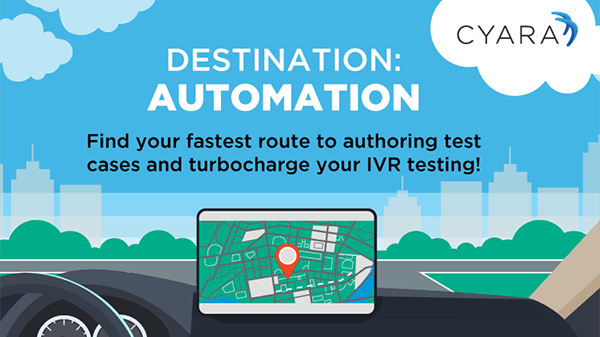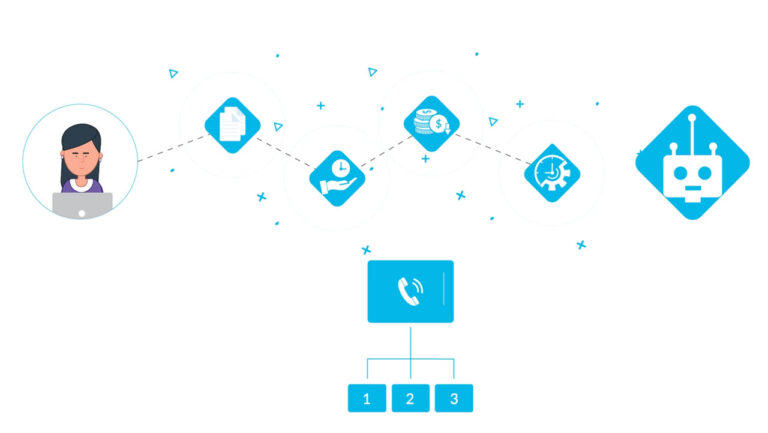Cyara Solutions:
IVR Testing
IVR Success Starts with Comprehensive Automated IVR Testing

Quickly and efficiently resolving customer inquiries and problems is essential — and, it’s why so many contact centers invest in Interactive Voice Response (IVR) technology.
What is an IVR? Interactive Voice Response (IVR) technology has been around for more than 30 years — and for good reason. This convenient, cost-effective solution allows incoming callers to navigate phone systems to speak with an agent, resolve an issue, or make an inquiry. Many IVRs serve as an effective self-service solution that helps customers find the answers to their own questions without ever speaking to a live agent. Others are designed to collect information and route callers to the right agents.
IVR System Architecture
So how does IVR technology work? It makes use of voice and dual-tone multi-frequency (DTMF) tones to receive user input and provide responses through telephone lines. IVRs provide automated customer service, allowing customers to interact with the IVR system without having to speak directly to a customer service representative or, should further assistance be required, route a customer directly to the correct agent.
These systems are designed to streamline customer service operations and make it easier for customers to access information quickly and efficiently. IVRs usually rely on pre-recorded messages or prompts that guide the user through a series of choices and provide responses based on the input received. They can also be programmed to accept free-form speech, leverage conversational AI and respond accordingly.
There are three components to the IVR system architecture that are helpful to have:
- IVR software is used to create the prompts, menus, and responses that make up the IVR system
- IVR hardware includes phone lines, modems, and other telephone equipment used to connect these systems with customers
- IVR hosting services provide the infrastructure necessary to make an IVR system available to customers
While IVR technology has been a mainstay of customer contact centers, a number of factors in today’s world have made it more integral than ever. These include the renewed importance of automation, an increase in the number of calls, and the addition of speech-recognition conversational interfaces. Essentially, IVR technology is not only a tried-and-true customer self-service channel, but it is also the wave of the future.
But even with proven technology like IVR, growing pains are possible. One of the greatest challenges that companies now face is how to handle the additional complexity of increasingly sophisticated IVR systems. These complex systems need to be carefully monitored and maintained to ensure they continue to deliver the experience customers expect. As a result, the need for comprehensive IVR testing solutions has also grown significantly.
IVR Testing Resources
Infographic: Destination Automation with Call Explorer
Product Video: Cyara Call Explorer
The Importance of IVR Testing
Your IVR is at the forefront of customer experience. A customer calling with a simple question can easily become frustrated if the call is mistakenly disconnected by the IVR, or if “pressing two” does not lead to the logical next step. Simply put, if your system doesn’t work the way you intended, you risk needlessly alienating your customers.
IVR testing gives you a line of defense against errors like these. An IVR testing checks that the prompts and self-service applications work as intended. It also checks your call transfer and routing options do exactly what they say, every time — as well as measures and monitors the maximum call volume at which they can continue to work.
In addition to catching mistakes, IVR testing makes it possible to view the IVR journey from the customer’s perspective and ensure it’s as convenient and easy to follow as possible. You may think you’ve designed an intuitive system, but without proper testing, you could be leaving users confused and unable to get the answers they need.
Finding the Right IVR Testing Solution
IVR testing is an essential practice that helps contact centers operate at peak performance. But not all testing methods are created equal. Some call centers rely on manual testing, often performed by agents or IT staff, to spot-check that the IVR is functioning at the start of the business day. Alternatively, some businesses rely on IT staff to manually test that changes to an IVR have been deployed correctly. However, manual testing is both time-consuming and expensive. As the complexity of the IVR increases, for example by adding conversational AI, this manual task becomes impossible.
Automating the process of IVR testing removes these barriers. With automated testing, it’s possible to test more often and more thoroughly, to ensure performance consistency and catch issues before they affect your customer experience.
Regardless of the testing method you choose, the main challenge to address with modern IVR testing is system complexity. Most voice self-service environments incorporate different technical components, such as IVR software (voice portal), VoiceXML applications, speech recognition, VUI, text-to-speech, integrations into CRM and third-party systems, and IP telephony infrastructure that must all work together. New technologies, such as visual IVR, voice-enabled artificial intelligence (AI), and conversational user interfaces exacerbate the challenge.
Additionally, IVR systems are famous for housing many undocumented – and out-of-date – out-of-date call flows. The effort it takes to manually document a large IVR system is slow and resource-intensive, and many companies simply do not do it. Without proper IVR documentation, it’s very difficult to create an IVR map and write test scripts. Solutions that perform IVR discovery and document findings are among the most effective ways to remedy the issue.
These common challenges with IVR system management often lead companies to seek automated IVR testing solutions that can cover the broad range of testing needs without the additional headcount or staffing costs associated with manual testing.
While automated IVR testing can offset the costs associated with manual testing, the real value of automation lies in the ability to increase your testing scope. In an ideal world, you would test 100 percent of the time. Unfortunately, full testing capabilities cannot be reached with manual testing alone. The more automated processes you adopt, the most testing you can implement which leads to fewer defects escaping into production.
To assure a flawless customer experience, organizations should invest in comprehensive IVR testing solutions that can:
IVR Documentation & Mapping
Automated calls crawl through entire IVR systems, documenting existing IVR call flows and applications and providing a complete map of all possible journeys and endpoints.
Automate & Schedule Tests & Campaign
Reduce manual, repetitive work by automating functional and regression testing and scheduling IVR tests to map time-based IVR flows when its best for the business.
Audio Capture & IVR Transcription
Test for speech recognition with statistical language modeling (SLM) and access links to all audio heard and transcribed into text from each node of the IVR to help you understand at which point on the IVR each audio prompt was present.
Simplify Test Case & Campaign Management
Organize and store libraries of automatically generated test cases that are easy to update when IVR design changes are made.
Ensure IVR Performance at Scale
Perform load testing to ensure that your IVR functions as designed during peak times
Monitor IVR Performance
Ensure that IVR customer journeys you’ve built perform as they should in live production environments with visual, interactive dashboards that simplify troubleshooting and accelerate MTTR.
Types of Automated IVR Testing
IVR Discovery and Documentation Testing
Many enterprises have an updated IVR system, but they lack current call flow and customer journey documentation. Companies in this position have to either manually explore their IVR software or deploy system changes based on risky assumptions and hope for the best.
Solutions like Cyara Velocity can fully document the IVR software and provide multiple ways to author IVR test scripts for functional and regression testing.
Learn about Cyara Velocity and IVR Discovery.
Automated IVR Functional Testing
IVR development teams are under tremendous pressure to add new functionality and improve customer experience. While Agile and DevOps processes have accelerated development, the reality is that IT teams often deprioritize IVR testing in favor of devoting resources to newer or higher-priority projects. Testing dates are pushed out while ”go-live” dates are not, reducing the time to test and increasing the risk of defects slipping into production.
Functional testing is a quality assurance practice that ensures the software your teams develop and deploy conforms to all your business requirements. That means ensuring newly developed or updated IVR systems perform as designed.
Automated scripting is the best practice for these kinds of cases, as it ensures your test scripts are always up-to-date and in line with expectations. Solutions like Cyara Velocity can automatically document and create test scripts, as well as automatically execute tests.
Learn about Cyara Velocity and Best Practices for IVR Testing.
Automated IVR Regression Testing
Regression testing is a type of software testing that checks that previously developed and tested software still functions as designed, even after code changes, updates, additions, and integrations. For IVRs, regression testing should ensure that updates have not broken any other elements of the IVR system, such as call flows, recordings, database lookups, or routing connections.
You can conduct automated IVR regression testing by creating a library of test cases and test blocks that can be used individually, as needed, or as part of complete, automatically run regression testing campaigns. Automation takes less time than manual testing, so you can cover more of your system on a regular basis.
Learn about Cyara Velocity, Regression Testing, and other Best Practices for IVR Testing.
Statistical Language Modeling Testing for Speech Recognition
If you choose to implement Statistical Language Modeling (SLM) for speech recognition, you’ll need to test the Voice User Interface (VUI) for each language, application logic, and performance at the interaction level. IVR testing platforms that are tailored to SLM can perform these tests and reduce the manual work of speech testers.
Learn about Cyara Velocity and Best Practices for IVR Testing.
Automated IVR Test Case Updating
IVRs need to be tuned and updated constantly — whether you’re adding a promotional offer, altering the menu, or making improvements to the customer journey. If you’re not regularly testing changes to stay on top of quality, you limit your visibility and understanding of your IVR system’s overall performance and risk letting development defects sneak into production.
The best way to keep pace with changes is to employ a testing solution that automatically updates IVR test cases when you modify your call flow or make changes to recordings.
Learn about Cyara Velocity and IVR Discovery.
Load and Performance Testing Your IVR
Call spikes are often triggered by external events that are difficult to predict. A sustained high volume of calls can put pressure on IVR software and lead to outages or failures. The most effective way to ensure that IVR software is prepared for call spikes and sustained traffic is to use a solution that automatically generates thousands of simultaneous calls. Load and performance tests put intended pressure on your system with synthetic traffic to identify potential breakpoints at individual and whole-system levels to find and address possible issues before they impact your customers.
Stress Testing
Stress testing, also known as endurance testing, is a vital part of evaluating the performance and reliability of an IVR system. It allows us to simulate real-world usage scenarios and identify any potential bottlenecks or issues that may affect customer experience. Stress testing also helps to gauge the system’s response time, stability, scalability, and capacity. By putting the system under pressure, we can ensure that it will stand up to the demands of heavy call volumes and provide our customers with an optimal experience. Ultimately, stress testing helps us to build IVR systems that are reliable and robust enough to handle any customer interaction.
Soak Testing
While similar to stress testing, soak testing involves running a system for an extended period of time to observe how well it can handle high-load situations and long-term usage conditions. This process allows developers to identify any potential issues, glitches or bugs that could arise after the system is implemented. It also helps ensure that the system meets its performance requirements and can handle sustained high-load traffic without crashing or slowing down. Soak testing allows developers to make necessary improvements before a system is put into production, helping them ensure the highest quality IVR service for their customers.
Graduated Testing
Graduated testing involves creating a series of tests that gradually increase in complexity, allowing for the evaluation of each component before moving on to the next. This process allows you to identify any issues early on so that they can be addressed quickly and efficiently. Graduated testing also ensures that the IVR system is prepared for any unexpected events or changes in the environment, allowing it to perform optimally and accurately.
Avalanche Testing
Avalanche testing simulates real-life user usage scenarios and interactions in order to ensure that the system can handle large numbers of users without any issues. This type of testing helps identify potential bottlenecks and degradation in performance when dealing with high user volumes. It is essential for ensuring the system can provide a satisfactory user experience, even when it needs to handle large numbers of concurrent users.
Disaster Recovery Testing
Disaster recovery testing for IVR systems can be extremely beneficial in helping to ensure that your deployment is resilient and reliable. As part of disaster recovery testing, the IVR system undergoes a series of tests to evaluate its ability to withstand potentially unexpected events such as natural disasters, power outages, hardware failures or other technical issues. Testing helps to identify any weaknesses and helps to ensure that the IVR system can quickly recover from an incident, restoring service with minimal downtime. By implementing proper disaster recovery testing, organizations can rest assured that their IVR systems will continue to run reliably and securely, even during unexpected events.
Continuous Testing for IVRs
Continuous testing for IVR systems is an important part of ensuring their reliability and accuracy. It allows for testing of the whole system, including different components like voice recognition software, menus, and other features. By continuously testing throughout the development cycle, developers can identify issues in real-time and make changes as soon as possible to keep the system running smoothly.
This helps to minimize downtime and ensure that users have a positive experience with the IVR system. Continuous testing also helps to identify potential problems before they become major issues, allowing for proactive measures to be taken to avoid disruption or service outages. By using continuous testing, developers can keep an IVR system running optimally and ensure that customers receive a satisfactory experience every time they use it.
Learn about Cyara Cruncher and Load and Performance Testing or read our blog articles, Best Practices in Performance Testing for CX Systems and Continuous Testing Saves Your Brand Time, Money, and Reputation
Customer Experience Monitoring for IVR Software
Can a customer reliably connect and complete interactions with your IVR? Will your organization discover an IVR defect before the customer does? These are questions that plague many companies. Customer experience monitoring, or testing in production, proactively identifies issues, gives real-time assessment, and enables comprehensive coverage of digital and voice channels.
Traditionally, businesses have deployed passive monitoring solutions that may provide a high-level overview of customer experience systems but it’s not telling the whole story; it lacks insight from the customer’s point of view.
By actively monitoring the systems from the user’s perspective, mimicking their behavior and following specific customer journeys, you give your business a clear view into how customers actually interact with your IVR and alert you to any problems they may encounter along the way. An advanced IVR testing solution that can continuously send calls into IVR software and follow call flows just like real customers gives companies a clear view of their system performance from the customer’s perspective and uncovers issues before customers ever have to experience them.
Learn about Cyara Pulse and CX Monitoring solutions, then read our What Is an IVR? and Comparing Active and Passive Product Monitoring blogs.
IVR Testing Best Practices
Effective IVR testing measures the accuracy and reliability with which contact center systems answer calls, play correct messages, offer the right prompts, and route callers to the correct agents. The right solution will automate IVR testing on as many of these factors as possible, for a trustworthy, end-to-end view of your IVR system.
However, in order to ensure effective IVR testing, it’s important to take a holistic approach. This means taking into account all aspects of the system, from its user interface design, voice prompts and menu options, as well as integrations to other systems, through to the internal logic used in automated decision-making. When conducting tests, make sure to evaluate usability, compliance with industry standards and overall customer satisfaction.
Taking the time to properly test and refine your IVR system is well worth it in the long run, as it will help ensure a positive user experience and optimal system performance.
Assuring a Flawless Customer Experience
By taking the time to invest in proper IVR testing, companies can ensure that their customers are getting a positive experience when using their system. From making sure individual components of the system work properly to regularly maintaining the system and adjusting it based on customer behavior, there are many steps to creating a successful IVR.
IVR systems are a great asset to organizations looking to streamline customer service operations and provide customers with fast, efficient access to information. IVR systems use advanced technology and sophisticated algorithms to automate processes and provide cost savings while improving customer experience. They are invaluable for businesses that need to create streamlined customer service operations without sacrificing quality.
Ultimately, automated IVR testing is an effective way to ensure a positive customer experience. Proper testing and maintenance are essential to ensuring that customers feel heard, understood and valued by the companies they interact with. Companies should strive to continuously evaluate their IVR systems in order to deliver the best possible customer experience each time. With careful attention to detail, companies can be confident that they are providing their customers with the best possible experience.
Learn More
See how the Cyara Automated Customer Experience Assurance Platform can help you achieve your CX Assurance goals, and delight your customers.


